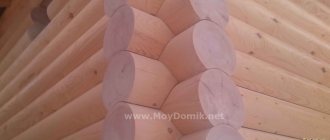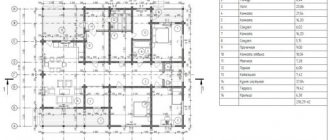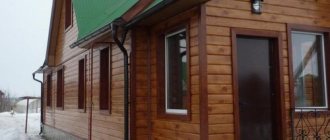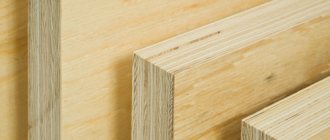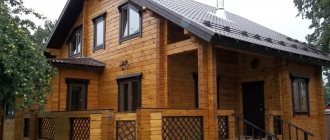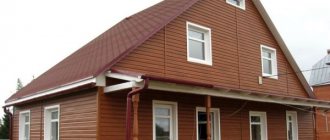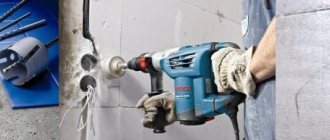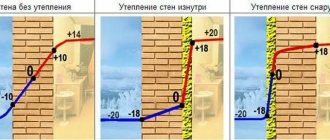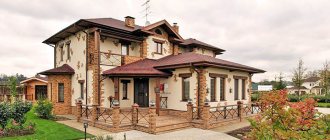06.07.2021
Author: Bruce Pine. Holz House expert.
- Features of materials for the construction of a wooden house
- Advantages and disadvantages of conventional timber
- Pros and cons of profiled timber
- Features of laminated veneer lumber
- Planed (non-profiled) timber: pros and cons
- Advantages and disadvantages of building with solid logs
- Pros and cons of wooden houses made of rounded logs
- What to choose?
The use of natural wood in the construction of private country houses is considered popular and prestigious in many countries. Wood is an environmentally friendly material with unique quality characteristics and aesthetic texture. Many varieties of wooden building materials have appeared on the modern architecture market: a house can be built from anything - from ordinary or rounded logs to laminated veneer lumber. There are also several types of timber. To understand the pros and cons, the distinctive features of different types of timber and understand why laminated veneer lumber is better than rounded logs, we suggest reading this article.
Features of materials for the construction of a wooden house
All wooden building materials have common features based on the properties of natural wood. The advantages of wood over other materials lie primarily in its environmental friendliness. Wood is better able to create a favorable microclimate in the house and maintain natural air humidity; coniferous wood saturates the air with beneficial phytoncides. Houses made from lumber are usually characterized by simplicity and high speed of assembly. It will not take much time to erect a log house or build a house from timber. Wood is a fairly durable material, although it is light in weight. Therefore, houses built from natural wood are reliable, durable, and do not require a powerful, expensive foundation. Thanks to the low thermal conductivity and high sound-proofing properties of wood, houses made of logs and timber retain heat better, are resistant to winds and drafts, and do not let in extraneous sounds from the street.
Types of lumber may differ qualitatively from each other. Both timber and logs are made from coniferous or a few deciduous trees. Coniferous trees are more often used in the production of lumber, as they are of high quality at a relatively low cost.
Advantages of a sauna made of timber
The popularity of buildings of this type is due to several points:
- Absolutely environmentally friendly . The wood contains no chemicals, the entire structure is breathable, which allows you to maintain an ideal microclimate and normal humidity. Species such as pine and spruce are especially breathable.
- Strength and tightness . The tongue-and-groove locks hold all the slats together well and prevent them from loosening. This protects against rapid wear of the structure, does not require large expenses for fastening and additional insulation.
- Low thermal conductivity . It is ensured by good tightness of the structure. As a result, the heat inside the steam room is retained for more than a day, which allows you to save on fuel.
- Easy to assemble . This is achieved again thanks to special locks. The slats are simply placed one on top of the other, making it possible to build a bathhouse without the use of special heavy equipment.
- Fast construction . Even if you have no experience, you can assemble a bathhouse from any type of timber within 1-4 weeks. Professionals erect even complex structures within 1-2 weeks.
- Long service life . The minimum service life is 40-50 years, and if you take good care of the bathhouse, then such buildings will last much longer. With proper operation with good ventilation and periodic treatment with an antiseptic, structures can even last over 100 years.
- Light weight . Since the structure, even with a roof, is not very heavy, it is possible to significantly save on the construction of an expensive and complex foundation.
- Uniform shrinkage . Even if shrinkage occurs, the building will not change its geometric shape. The corners will remain intact, no cracks or gaps will appear. Even with a high level of shrinkage, distortions will not be observed.
One of the main advantages of timber baths is their microclimate. While it is hot in the steam room, pleasant coolness will reign in the dressing room. At the same time, there are no cold bridges in such buildings, which protects against freezing and drafts.
Advantages and disadvantages of conventional timber
Builders who have had to deal with ordinary timber can note the simplicity and speed of constructing a building from this material. The timber can have a square or rectangular cross-section and is suitable for almost any type of building. Regular timber is low cost, easily accessible and, like all lumber, is an environmentally friendly construction product. The disadvantage of the material in comparison with other types of timber is its tendency to deform: after shrinkage, ordinary timber can become covered with cracks, and if preparation and construction technologies are not followed, serious changes in shape can occur. In addition, ordinary timber requires additional external and internal finishing.
Important points when choosing a bath
When purchasing timber or a turnkey bathhouse, you should definitely pay attention to the following points:
- there should be no cracks on the lamellas; they may appear on the material during drying;
- when purchasing a turnkey bathhouse, be sure to pay attention to the presence of waterproofing and thermal insulation;
- There shouldn’t be any toxic smell coming from the boards, you shouldn’t hear about how glue or something else smells like that, good wood doesn’t smell like chemicals;
- specify what glue was used to glue the timber; it should not contain formaldehydes, they are very dangerous to human health;
- pay attention to the edges of the boards, they should be evenly cut and without pronounced differences;
- When purchasing a ready-made bathhouse, look at all the fasteners; they must be of high quality and airtight.
Attention! Always ask the seller for a quality certificate for the presented product and all finishing, if any. If they cannot provide such documents, it is not worth taking the material, no matter what the reasons are given.
Pros and cons of profiled timber
When working with profiled timber, additional cladding of the house may not be necessary. Thanks to the presence of convenient connections - profiles - the house is built from tightly fastened elements, there are no gaps between them. This is one of the best natural building materials that are environmentally friendly and easy to build. The surfaces of profiled timber are treated in production with special environmentally friendly compounds - antiseptics and fire retardants. Due to them, the house becomes more fire-resistant, lasts for many years and is not exposed to negative environmental influences. Profiled timber also has possible disadvantages. When shrinking, lumber dries out and cracks may form, especially in the case of choosing square-section timber. Serious changes in the shape of the timber may also occur if its manufacturing technology is violated.
Features of laminated veneer lumber
According to most experts, laminated veneer lumber is definitely considered the leader in material quality. The unique technology for the production of laminated veneer lumber has made it possible to create a universal, durable and completely environmentally friendly building material. Thanks to the tight gluing of lamellas made from sawn and defect-free boards, laminated veneer lumber has special strength - its strength exceeds solid wood by 60-70%. In production, the material is necessarily treated with antiseptics and fire retardants, and quality checks are carried out repeatedly. Glued laminated timber gives minimal shrinkage - only 1-2%. This allows you to move on to interior decoration and communications immediately after assembling the house kit. Glued laminated timber is practically not subject to deformation, does not warp or crack. It is easy and convenient to work with; if you have well-written design documentation, a house can be assembled from a ready-made house kit in a very short time. The durability and fire safety of laminated veneer lumber buildings make them attractive to customers not only of private country houses, but also of commercial real estate. Among other things, houses made of laminated veneer lumber look very impressive and do not require additional finishing. Glued laminated timber has virtually no disadvantages. The only thing that may confuse a buyer is the relatively high starting price of the house. But with all the unique properties of the timber, this cost pays off many times over.
Profile types
There are two common ones: the so-called German and Finnish.
German profile
Finnish profile
German: Another name for "comb". Look at this photo and agree that the comparison is correct. The profile has many “tubercles and pits” that ensure reliable connection of the timber to each other. In addition, German does not require inter-crown insulation.
Finnish: It consists of a pair of tall teeth and a pair of corresponding pits. It fits tightly during installation, but unlike the German profile, it requires installation of inter-crown insulation.
Preservation of the “operability” of the grooves is achieved under the condition of appropriate storage before the start of installation work. If the PB lies on the street for a long time, exposed to aggressive factors, this will lead to deformation of the fastening comb. And it will be difficult to achieve a tight fit of the crowns, one into the other.
Planed (non-profiled) timber: pros and cons
Planed non-profiled timber has a square or rectangular cross-section and an absolutely smooth surface. To obtain smooth surfaces, the timber is dried in special chambers. The advantages of this type of timber are its affordable cost, good thermal insulation properties and resistance to weather conditions. This is a good option for lumber, but it has significant drawbacks. Planed non-profiled timber gives a fairly large percentage of house shrinkage - 10-15%. In addition, the material is subject to deformation and often cracks when the walls shrink and dry out. Despite treatment with antiseptics, non-profiled timber can be affected by fungus. Due to the lack of profile connections, as is the case with profiled timber, this type of material retains heat less well and allows drafts to pass through.
Advantages and disadvantages of building with solid logs
From time immemorial, houses have been built from solid logs. This is a completely natural building material, most often made from coniferous trees, which contain a natural antiseptic. Houses made from solid logs are strong, reliable and durable. The material is processed by hand, which makes it resistant to cracking. A serious disadvantage of this type of lumber is the high degree of shrinkage - 10-15%. Such shrinkage can last up to two years, and all this time the building will dry out and deform. In order for the building to retain the desired shape and not lose its performance qualities, it is important to have construction skills and carefully follow the house construction technology.
A brief excursion into the topic
We are considering profiled timber, so just in case, let me clarify that it differs from non-profiled timber in that it has auxiliary fastenings (ridges, grooves, locks) that allow the assembly of links, providing reliable thermal insulation.
And ordinary material has a “classical” quadrangular shape. Usually in the form of a rectangle or square with uniform thickness. However, both beams can have a one-sided or two-sided convex shape.
Domestic enterprises most often produce profiled timber with sections (mm): 95 x 95, 95 x 145, 145 x 145, 145 x 195, 195 x 195. The standard length is 6000. In general, sections range from 50 to ... mm . For the construction of external walls of a house, cottage, bathhouse, as a rule, a section of 145 x 145 mm is used. Anything smaller goes to the interior walls. By the way, modern equipment allows you to trim a log with an accuracy of 1 mm.
In cold weather, buildings made of Profiled Beam (later, sometimes shortened to PB) must be heated, but in hot weather, it is quite comfortable in it even without air conditioning.
It is necessary to pay attention to such an important indicator as the moisture content of the timber. This greatly affects the quality and technology of installation. The modern market offers timber with natural humidity (from 21 to 30%) and chamber drying (from 11 to 20%).
Shrinkage of the first option can reach 5-10%. Therefore, after assembling the structure, a break of several months is necessary for the “wooden box” to shrink. If PB dried in a thermal chamber is used, the shrinkage time is reduced by two to three times. Material that has undergone forced drying is more expensive than material dried under natural conditions.
But timber that has been impregnated with fire-bioprotective substances (fire retardants and antiseptics) in a factory setting (under pressure in an autoclave) is much more effective than conventional impregnation performed in normal household conditions.
Pros and cons of wooden houses made of rounded logs
Rounded logs are obtained from dry lumber by turning on machines. The result is a material with a completely smooth surface. This is a relatively inexpensive and durable building material, completely natural and environmentally friendly. Houses made from rounded logs can be erected fairly quickly, provided the weather is dry. Externally, the buildings look elegant and aesthetically pleasing, but require additional finishing. The main disadvantage of the material is, like any type of log, an increased degree of shrinkage at home. After shrinkage, the house is subjected to the caulking process. A rounded log can be exposed to negative environmental influences, as a result of which it becomes severely cracked and deformed. Even when lumber is treated with fire retardants, a house made of galvanized logs still remains a fire hazard. When building a house from galvanized logs, it is important to choose the highest quality type of wood - the harder and more moisture-resistant the wood species, the better.
What to choose?
When choosing laminated veneer lumber or rounded logs, you need to weigh all the pros and cons, determine your capabilities and wishes. The natural properties, appearance and cost of lumber vary greatly among different types. If we compare the thermal insulation properties, strength characteristics, and resistance to environmental influences, laminated veneer lumber definitely remains the best natural building material. When choosing between laminated veneer lumber and other wooden materials, the only question that may arise is the price. The relatively high cost of laminated veneer lumber is fully justified due to its high technology, excellent quality and aesthetic appearance, and excellent performance characteristics. Such a house will last for many years without losing its performance properties. And thanks to the high speed of assembly and low shrinkage, you can move into your new home immediately after its construction is completed.
Key advantages of using the material
Timber logs are used in the construction of summer country houses, permanent cottages for year-round use, as well as for bathhouses, garages, and various outbuildings. We can list the main advantages of profiled timber:
- Affordable price. This material is significantly cheaper than laminated timber or brick, which makes it more affordable for owners of suburban areas.
- Environmental friendliness. Solid wood retains the ability for natural air exchange: it takes excess moisture from the home atmosphere and releases it back as needed. As a result, it is always comfortable to be in the premises, and it will be easy to breathe in such a house.
- Strength and durability. With proper assembly and regular treatment, the walls can last for decades; the house will not require major repairs. However, he will need regular maintenance care and attention from his owner.
- Light weight. Natural wood is one of the lightest building materials; it does not require a deep concrete foundation. This further reduces construction costs, since it is the foundation that requires large investments.
- Speed of construction. The kit for assembling a log house is pre-made at the production site, and then the house is assembled from ready-made elements. All of them are carefully adjusted to each other, which eliminates the formation of cracks in corners and walls.
- Good thermal insulation qualities. Wood retains heat much better than concrete or brick, which allows you to save on insulation and maintain a comfortable indoor temperature.
- Effective sound insulation. Wooden walls block street sounds, making the rooms quiet and comfortable.
- Excellent decorative qualities. If the sides of the timber are given a semicircular shape, the log house will resemble a log house. Interior walls can be made perfectly smooth for ease of decorative finishing. They do not require rough work; various design ideas can be brought to life.
One of the positive features of this material is its relatively low shrinkage, not exceeding 3.5-6%. Preliminary natural or chamber drying allows you to remove most of the moisture from the material, thereby eliminating further deformation and the formation of cracks. The house will not need caulking as often as a log house made of logs or planed timber with natural moisture. Considering all the advantages, we can conclude: profiled timber is perfect for implementing a wide variety of construction projects.
